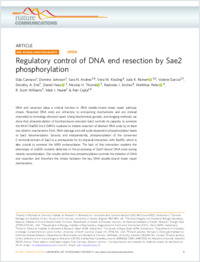Regulatory control of DNA end resection by Sae2 phosphorylation
- Cannavo, Elda Institute for Research in Biomedicine (IRB), Faculty of Biomedical Sciences, Università della Svizzera italiana, Switzerland
- Johnson, Dominic Genome Damage and Stability Centre, School of Life Sciences, University of Sussex, Brighton, BN1 9RH, UK
- Andres, Sara N. Genome Integrity and Structural Biology Laboratory, National Institute of Environmental Health Sciences, Department of Health and Human Services, US National Institutes of Health, Research Triangle Park, 27709-2233, NC, USA
- Kissling, Vera M. Department of Biology, Institute of Biochemistry, Eidgenössische Technische Hochschule (ETH), Zürich, 8093, Switzerland
- Reinert, Julia K. Friedrich Miescher Institute for Biomedical Research, Basel, 4058, Switzerland - University of Basel, Basel, 4056, Switzerland
- Garcia, Valerie Genome Damage and Stability Centre, School of Life Sciences, University of Sussex, Brighton, BN1 9RH, UK
- Erie, Dorothy A. Department of Chemistry, Lineberger Comprehensive Cancer Center, University of North Carolina, Chapel Hill, 27514, NC, USA
- Hess, Daniel Friedrich Miescher Institute for Biomedical Research, Basel, 4058, Switzerland
- Thomä, Nicolas H. Friedrich Miescher Institute for Biomedical Research, Basel, 4058, Switzerland
- Enchev, Radoslav I. Department of Biology, Institute of Biochemistry, Eidgenössische Technische Hochschule (ETH), Zürich, 8093, Switzerland
- Peter, Matthias Department of Biology, Institute of Biochemistry, Eidgenössische Technische Hochschule (ETH), Zürich, 8093, Switzerland
- Williams, R. Scott Genome Integrity and Structural Biology Laboratory, National Institute of Environmental Health Sciences, Department of Health and Human Services, US National Institutes of Health, Research Triangle Park, 27709-2233, NC, USA
- Neale, Matt J. Genome Damage and Stability Centre, School of Life Sciences, University of Sussex, Brighton, BN1 9RH, UK
- Cejka, Petr Institute for Research in Biomedicine (IRB), Faculty of Biomedical Sciences, Università della Svizzera italiana, Switzerland - Department of Biology, Institute of Biochemistry, Eidgenössische Technische Hochschule (ETH), Zürich, 8093, Switzerland
-
01.10.2018
Published in:
- Nature communications. - 2018, vol. 9, p. 4016
English
DNA end resection plays a critical function in DNA double-strand break repair pathway choice. Resected DNA ends are refractory to end-joining mechanisms and are instead channeled to homology-directed repair. Using biochemical, genetic, and imaging methods, we show that phosphorylation of Saccharomyces cerevisiae Sae2 controls its capacity to promote the Mre11-Rad50-Xrs2 (MRX) nuclease to initiate resection of blocked DNA ends by at least two distinct mechanisms. First, DNA damage and cell cycle-dependent phosphorylation leads to Sae2 tetramerization. Second, and independently, phosphorylation of the conserved C- terminal domain of Sae2 is a prerequisite for its physical interaction with Rad50, which is also crucial to promote the MRX endonuclease. The lack of this interaction explains the phenotype of rad50S mutants defective in the processing of Spo11-bound DNA ends during meiotic recombination. Our results define how phosphorylation controls the initiation of DNA end resection and therefore the choice between the key DNA double-strand break repair mechanisms.
- Language
-
- English
- Classification
- Biological sciences
- License
- Open access status
- gold
- Identifiers
-
- RERO DOC 326626
- DOI 10.1038/s41467-018-06417-5
- ARK ark:/12658/srd1318910
- Persistent URL
- https://n2t.net/ark:/12658/srd1318910
Statistics
Document views: 210
File downloads:
- Texte intégral: 224
